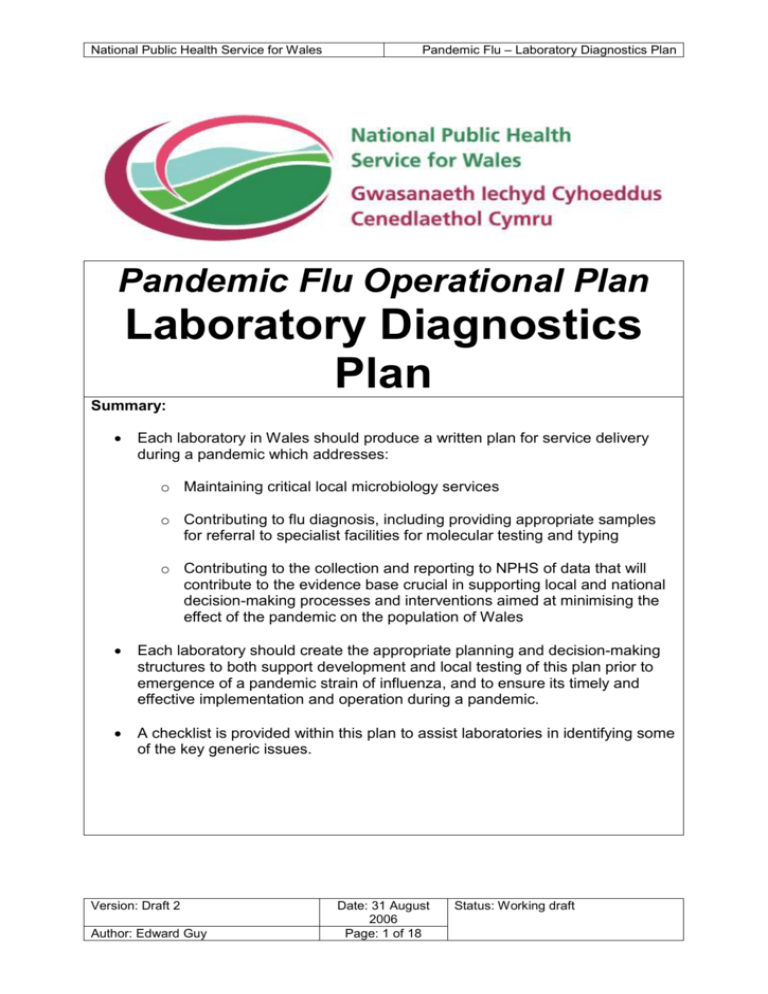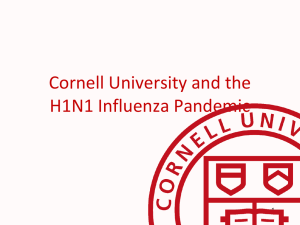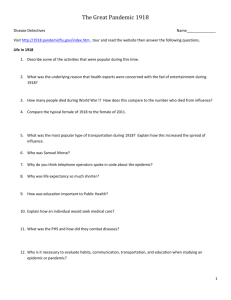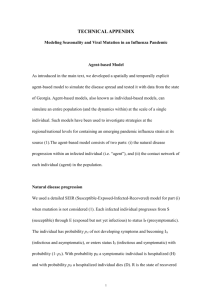Laboratory Diagnostics Plan
advertisement

National Public Health Service for Wales Pandemic Flu – Laboratory Diagnostics Plan Pandemic Flu Operational Plan Laboratory Diagnostics Plan Summary: Each laboratory in Wales should produce a written plan for service delivery during a pandemic which addresses: o Maintaining critical local microbiology services o Contributing to flu diagnosis, including providing appropriate samples for referral to specialist facilities for molecular testing and typing o Contributing to the collection and reporting to NPHS of data that will contribute to the evidence base crucial in supporting local and national decision-making processes and interventions aimed at minimising the effect of the pandemic on the population of Wales Each laboratory should create the appropriate planning and decision-making structures to both support development and local testing of this plan prior to emergence of a pandemic strain of influenza, and to ensure its timely and effective implementation and operation during a pandemic. A checklist is provided within this plan to assist laboratories in identifying some of the key generic issues. Version: Draft 2 Author: Edward Guy Date: 31 August 2006 Page: 1 of 18 Status: Working draft Pandemic Flu – Laboratory Diagnostics Plan National Public Health Service for Wales Contents 1. Background 2 2. Developing the Laboratory Plan 4 Appendix A Checklist for Laboratory Response Plan 6 Appendix B Arrangements for the development, technology transfer into Wales, and operational implementation of a new assay for the pandemic strain 10 Appendix C Routine laboratory methods for the diagnosis of pandemic influenza in Wales. 12 Appendix D Outline plan for laboratory action at various stages of the pandemic 16 Version: Draft 2 Author: Edward Guy Date: 31 August 2006 Page: 2 of 18 Status: Working draft National Public Health Service for Wales 1 Pandemic Flu – Laboratory Diagnostics Plan Background An influenza pandemic is likely to place a very heavy burden on the healthcare system. Within pathology, microbiology services will be placed under particular strain due, not only to the increase in diagnostic work that will need to be undertaken to support individual patient management, but also to the contribution to local infection control, and to national surveillance initiatives aimed at minimising the impact of the pandemic. Clearly, such increased demands on resources at a time where these will likely be reduced due to the impact of the pandemic, will require a range of measures to be introduced and arrangements put in place in order to ensure that critical functions can be protected. The aim of this document is to promote the establishment and development of appropriate planning and decision-making structures within each NHS Trust in Wales, and the introduction of appropriate procedures and arrangements, that will ensure each laboratory is able to respond to the challenges of an influenza pandemic in terms of delivery of local and national diagnostic and surveillance functions. Key challenges and issues among those likely to be faced by each laboratory include: Increased workload associated with suspected and confirmed cases of pandemic influenza. Decreased workforce due to influenza affecting either staff or their dependents, and increased fatigue or stress due to prolonged working hours. Requirement for the introduction and maintenance of facilities, equipment and procedures for the appropriate handling and testing of specimens from suspected and confirmed cases of influenza. Requirement for local policies and procedures for the collection by NHS Trust staff of specimens from suspected and confirmed cases of influenza and contributing to training of frontline NHS staff. Disruption to the supply chain and access to critical inventory needs compromised. Disruptions affecting critical support services such as maintenance and repair of essential facilities or items of equipment. Version: Draft 2 Author: Edward Guy Date: 31 August 2006 Page: 3 of 18 Status: Working draft National Public Health Service for Wales 2 Pandemic Flu – Laboratory Diagnostics Plan Developing the Laboratory Plan Each laboratory will require a written plan for an influenza pandemic. In addition to addressing maintenance of critical local clinical-support services the plan will need to ensure continuity of support for the wider NHS Trust plan (e.g. infection control services, support of Occupational Health contingencies, etc.) and support for regional and national initiatives. The latter will be coordinated by the National Public Health Service for Wales and will be described in detail within the NPHS Surveillance Plan. In developing a pandemic influenza response plan, each laboratory should: 1) carry out a full review of the availability of Category Level 3 facilities and risk assessments of the handling of pandemic flu both within and outwith such facilities. 2) identify appropriate members of staff to serve as Clinical and Technical Leads for local influenza pandemic response activities. During the current interpandemic phase these Leads will serve as coordinators for the development of the laboratory plan and will be a point of contact within the laboratory for national influenza pandemic preparedness initiatives. During a pandemic these Leads will serve as the point of contact with NPHS Wales for the two-way exchange of health intelligence and the health information briefings that will take place regularly. In view of the crucial nature of this role, two deputies should be identified in case of illness. 3) carry out a review of all work undertaken and prioritise activity. The NHS Trust plan will likely identify explicit areas of activity that will cease or be significantly curtailed during an influenza pandemic. This will result in a decrease in demand in some areas of the laboratory and may even permit complete cessation of some functions. Remaining work will need to be prioritised in order to ensure that resources can be focused upon the most critical functions. While these will include support of national pandemic influenza initiatives, there may be differences in other areas of work depending upon the nature of the NHS Trust in which each laboratory is based. Work should be categorised as follows: Critical Failure to provide will result in either: 1) immediate risk of severe adverse outcome to patients, staff or the wider public health. 2) compromise to the NHS Trust influenza pandemic response plan. 3) compromise to functions proscribed in the NPHS Wales Influenza pandemic response plan. High Priority Failure to provide will result in either: 1) risk of severe adverse outcome to patients, staff or the wider public health if Version: Draft 2 Author: Edward Guy Date: 31 August 2006 Page: 4 of 18 Status: Working draft National Public Health Service for Wales Pandemic Flu – Laboratory Diagnostics Plan this work is discontinued for a prolonged period. 2) immediate low to moderate risk of severe adverse outcome to patients, staff or the wider public health. Lower Priority No immediate risk of significant adverse outcome to patients, staff or the wider public health. 4) assess impact on microbiology services during an influenza pandemic based upon capacity to deliver the ‘critical’ and ‘high priority’ services identified above. Based on the assumption of infection rates of up to 25% during pandemic influenza and current NHS rates of absence due to sickness, estimates should be based upon peak absentee rates of approximately 15%. This is likely to persist for a period of 1-2 weeks. Any critical functions where expertise is limited should be identified, particularly where the absence of a relatively small number of staff may cause significant compromise to the ability to continue to provide these functions. A plan for cross-training of staff should be developed in order to address such issues. 5) review contingency plans associated with disruptions to support services. Based on current predictions for the duration of the initial pandemic period, significant disruptions are likely to be experienced for 6-12 weeks and possibly longer. Each laboratory should identify minimum critical stock levels and review and update inventories of supplies that will be in high demand during the pandemic period. 6) ensure local infection control policies are established and arrangements in place. Such arrangements should include guidelines for non-laboratory staff for the collection and transport of specimens and care of suspected or confirmed pandemic influenza cases. 7) ensure there is an appropriate occupational health plan for laboratory staff during the pandemic period. This policy should include arrangements for the monitoring and management of flulike illness and provision of education and support services for staff experiencing stress or raised concern in working with infected specimens. Appendix A contains a summary of the above information in a format intended to assist each laboratory in preparing for an influenza pandemic Version: Draft 2 Author: Edward Guy Date: 31 August 2006 Page: 5 of 18 Status: Working draft Pandemic Flu – Laboratory Diagnostics Plan National Public Health Service for Wales Appendix A Checklist for Laboratory Response Plan 4. Microbiology Services Key Points Aims 4.1 Establishment of planning and decisionmaking structures within laboratory To identify staff with responsibility for leading the planning process and, during a pandemic, to serve as a point of contact with relevant national health information dissemination and decisionmaking structures 4.2 Laboratory diagnosis of influenza To ensure early recognition of introduction of pandemic flu into local community, support clinical management, guide service planning, assist infection control and inform therapeutic decisions. Actions A) To identify a clinical lead (with appropriate cover) with responsibility for the development of a local influenza diagnostic plan and serve as a point of contact during the pandemic period A) Establish a local testing algorithm for the investigation of suspected influenza cases, when further guidance is provided by the NPHS B) Establish local strategies for the investigation of suspected outbreaks in the community and the healthcare setting. 4.3 Provision of surveillance data To guide and inform service response and planning. Version: Draft 2 Author: Edward Guy A) To identify a lead for surveillance data collection (with appropriate cover) who will support the implementation of national surveillance requirements as outlined in the NPHS Surveillance Plan Date: 31 August 2006 Page: 6 of 18 Not In Completed Started Progress □ □ □ □ □ □ □ □ □ Status: Working draft Pandemic Flu – Laboratory Diagnostics Plan National Public Health Service for Wales 4.4 Service Delivery To identify diagnostic services that must be delivered throughout the flu pandemic and plan for the continuity of the service A) Categorise diagnostic work into priority levels B) Develop plan for delivery of the essential services taking into consideration the possibility that up to 15% of staff may be unavailable due to influenza. 4.5 Contingency Planning To identify circumstances and factors that present a significant threat to service provision during the pandemic period Version: Draft 2 Author: Edward Guy B) Surveillance plan in place that covers electronic reporting of: influenza A diagnoses (CoSurv) bacterial isolates and antimicrobial susceptibilities from blood cultures and post mortems (CoSurv to migrate to DataStore) C) Identify and undertake any additional training to ensure continuity of essential diagnostics and key laboratory functions (eg IT support) D) Ensure appropriate laboratory facilities for likely increase in respiratory work to be carried out with appropriate biosafety level A) Identify stock levels of critical consumables and implement a review process to ensure that minimum levels required for the pandemic period can be achieved within the anticipated time between emergence of the pandemic strain and its arrival in the UK Date: 31 August 2006 Page: 7 of 18 □ □ □ □ □ □ □ □ □ □ □ □ □ □ □ □ □ □ Status: Working draft National Public Health Service for Wales 4.6 Infection control To ensure safety of local NHS staff in the collection and transportation of specimens 4.7 Training Introduce specific training aimed at increasing capacity within the laboratory to respond to the influenza pandemic Version: Draft 2 Author: Edward Guy and to C) Consider options for acquiring additional staff, e.g. by maintaining a register of staff recently retired. D) Define ‘essential’ and ‘non-essential’ visitors to the laboratory and introduce an appropriate policy during the pandemic period A) Produce guidelines for collection of specimens from suspected and confirmed cases of influenza and ensure clinical staff are fully aware of arrangements for safe transportation to the laboratory A) Introduce training of specific staff to supplement expertise where this is presently limited to a relatively small number of individuals B) Maximise general cross-training of staff in key areas of laboratory function C) Consider areas where adjusting the skill-mix may be possible during the pandemic emergency and ensure relevant staff have sufficient training to contribute as required A) Identify staff member(s) with responsibility for internal audit of plan and introduce audit Introduce measures processes assess B) Identify critical items of equipment and facilities where failure would compromise service provision and ensure appropriate safeguards are in place. 4.8 Review and audit of pandemic influenza Pandemic Flu – Laboratory Diagnostics Plan Date: 31 August 2006 Page: 8 of 18 □ □ □ □ □ □ □ □ □ □ □ □ □ □ □ □ □ □ □ □ □ □ □ □ Status: Working draft National Public Health Service for Wales response plan Pandemic Flu – Laboratory Diagnostics Plan effectiveness and functionality of the plan Version: Draft 2 Author: Edward Guy Date: 31 August 2006 Page: 9 of 18 Status: Working draft National Public Health Service for Wales Pandemic Flu – Laboratory Diagnostics Plan Appendix B Arrangements for the development, technology transfer into Wales, and operational implementation of a new assay for the pandemic strain There is currently no pandemic strain of influenza. For a pandemic to occur a new variety of influenza must appear. Current UK arrangements for the acquisition and co-ordinated delivery of any new assay for the detection and confirmation of the pandemic flu strain will be via dissemination of an international assay to key centres throughout the UK from the HPA Centre for Infection (WHO National Laboratory for Influenza - Head, Dr Maria Zambon). The designated centre within Wales is the NPHS Virology (Molecular Unit) Cardiff which will liaise directly with CfI (MZ) to agree technology transfer and implementation. During a pandemic the following process is anticipated: Version: Draft 2 Author: Edward Guy Date: 31 August 2006 Page: 10 of 18 Status: Working draft National Public Health Service for Wales Pandemic Flu – Laboratory Diagnostics Plan Multiple cases of influenza with rapid person to person spread identified outside of the UK New “pandemic” strain identified WHO Alert Phase 6 UK Alert Level 1 WHO-led International effort to establish sequence of new virus New assay established and rolled out to UK’s WHO Influenza Laboratory (HPA Centre for Infection - CfI) New assay rolled out from CfI to UK regional centres (NPHS Cardiff in Wales) Specialist service offered to laboratories throughout Wales (co-ordinated with by CfI) In practice once the assay is established at the Centre for Infection it is anticipated that technology transfer should be possible within a few days/weeks and subsequent laboratory diagnosis of pandemic influenza will rely upon molecular testing. Other Respiratory Virus Molecular Diagnostic assays available in Wales Current molecular diagnostic assays available to laboratories in Wales via the NPHS Molecular Unit Cardiff include: a) b) c) Assays for seasonal influenza including H3N2 H1N1 Assays for other respiratory viruses (RSV) Assays for Avian Influenza (H5N1) Version: Draft 2 Author: Edward Guy Date: 31 August 2006 Page: 11 of 18 Status: Working draft National Public Health Service for Wales Pandemic Flu – Laboratory Diagnostics Plan Appendix C Routine laboratory methods for the diagnosis of pandemic influenza in Wales. 1. OVERVIEW Viral Culture Non-molecular assays are more widely available in Wales. Virus culture will need to be maintained in order to produce virus strains for referral to CfI and part of the WHO pandemic plan. However, culture of virus outside of specialist facilities is not recommended. Such work would be undertaken on behalf of Wales by NPHS. Immunofluorescence Assays The role of direct immunofluorescence microscopy for influenza is difficult to predict since there is no way of knowing whether or not current assays will work and the availability of skilled technicians and fluorescent microscopes is variable across Wales. Serological Assays Serology for detection of influenza specific antibody will have little or no role during a pandemic. Samples sent to the laboratory can be stored for retrospective analysis. Point of care testing (POCT) There are developments in point of care testing for influenza (mostly based on EIA technology), such assays may be very useful during the flu season or a pandemic to enable rapid local diagnosis. Generally such assays are specific but not very sensitive. There is as yet no POCT for pandemic flu as this would be a new virus whose properties are not known, experience of POCT for respiratory infections is very limited in Wales. 2. TECHNICAL FRAMEWORK FOR LABORATORY DIAGNOSIS Laboratory diagnosis of viral respiratory infection is undergoing rapid development. The availability of solid phase EIA formats for detection of respiratory virus antigens, suitable for use in the clinic or non specialised laboratory, and the successful development of real time molecular assays for respiratory targets have greatly improved the potential availability and sensitivity of laboratory diagnosis of respiratory illness whether seasonal or in the event of a pandemic. Version: Draft 2 Author: Edward Guy Date: 31 August 2006 Page: 12 of 18 Status: Working draft Pandemic Flu – Laboratory Diagnostics Plan National Public Health Service for Wales In the immediate future it is likely that specialised assays (molecular and flu typing assays) will be performed in Wales at central specialist facilities on behalf of patients in hospital and the community. If near patient testing devices perform well, these are likely to be an important addition to direct IF as a rapid diagnostic test and could be offered directly by NHS Trusts throughout Wales. 1. Quality assurance and control In order to ensure reliability of health information provided during the influenza pandemic, all assays MUST be validated and operated according to the following principles: i. CPA accreditation of the testing laboratory ii. Standard operating procedures should be established across Wales for all influenza assays used, with any local variations both explicit and agreed by the NPHS National Coordinating Centre. iii. Evidence of validated sensitivity and specificity at a satisfactory level iv. Internal quality control and quality assurance procedures in place 2. Virus isolation in cell culture It is currently envisaged that Virus Culture will be undertaken by NPHS during an influenza pandemic a. Use of specific cell lines/strains able to support the growth of pandemic flu will follow advice from WHO. b. Stringent Biosafety measures will be required. c. Virus growth in culture will be essential for i. Strain typing during a pandemic ii. Assays to determine susceptibility/resistance to antivirals 3. Direct immunofluorescence assays a. Commercially available assays target different components of the influenza virus. Version: Draft 2 Author: Edward Guy Date: 31 August 2006 Page: 13 of 18 Status: Working draft Pandemic Flu – Laboratory Diagnostics Plan National Public Health Service for Wales b. The nature of any pandemic strain will determine whether current assays will be of any use. c. Rapid development of appropriate assays will likely follow the appearance of a pandemic strain, but there will be delay in large-scale production. d. Reading IF is subjective and difficult to control. e. Satisfactory performance in NEQAS as well as arrangements for IQC will be essential. f. Staff training for IF work is essential and will need to be incorporated into training plans to create a sufficient base of expertise if this method is to be used. g. High throughput is difficult 4. Near patient EIA assays a. These are largely untested in Wales b. Commercially available assays target different components of the influenza virus c. The nature of any pandemic strain will determine whether current assays will be of any use. d. Rapid development of appropriate assays will undoubtedly follow the appearance of a pandemic strain, but there will be delay in large-scale production. e. Satisfactory performance in NEQAS as well as arrangements for IQC are desirable, but schemes not currently available. f. No need for specific equipment for many assays. g. High throughput difficult. h. Ongoing review should be considered for the use of these assays for the whole of Wales as any significant new developments arise. 5. Serology Version: Draft 2 Author: Edward Guy Date: 31 August 2006 Page: 14 of 18 Status: Working draft National Public Health Service for Wales Pandemic Flu – Laboratory Diagnostics Plan a. The production of anti-influenza antibody follows infection or immunisation and serology can be used to diagnose recent/past infection and/or the level of immunity in an individual or community. b. The usefulness of serology to diagnose acute infections during a pandemic is likely to be small. c. Retrospective detection of specific antibody mat be of use in some clinical situations. d. Serology is likely to be of more value in determining levels of population immunity following immunisation campaigns than in acute diagnostics. e. All serological methods must be subject to the same quality standards specified above. 6. Molecular testing for Pandemic Influenza a. This will probably be the mainstay of diagnosis of pandemic influenza. b. Development of an appropriate assay will depend on the nature of the pandemic strain. c. An identified international network of centres will develop assays d. Wales will probably be guided by the WHO’s UK Influenza Reference Laboratory based within the Health Protection Agency. e. The number of laboratories in Wales able to offer molecular assays will depend on: i. The availability of molecular diagnostic facilities and equipment ii. The availability of skilled staff able to undertake molecular work iii. Biosafety considerations, especially if molecular suites employed during the pandemic have been designed primarily for noninfectious disease work. iv. The satisfactory performance of molecular laboratories in available internal and external quality schemes for infectious disease targets. v. The ability of labs to report molecular data to CDSC. Version: Draft 2 Author: Edward Guy Date: 31 August 2006 Page: 15 of 18 Status: Working draft National Public Health Service for Wales Pandemic Flu – Laboratory Diagnostics Plan Appendix D Outline plan for laboratory action at various stages of the pandemic WHO Phases 1, 2 and 3 (UK Alert level 0 – a pandemic strain does not exist) PRE PANDEMIC 1. This is the current situation, there is no pandemic influenza but there is concern over avian influenza and its severity and also evidence of circulation in the population of “normal” seasonal influenza, albeit at a low level at present. Laboratory Action: Maintain current practice – Utilise NPHS specialist molecular diagnostic facilities for seasonal influenza assays. Avian influenza investigated only if specifically indicated according to NPHS/HPA algorithms. Non-molecular assays provided by laboratories in Wales according to local protocols Each diagnostic laboratory in Wales should draw up a flu pandemic plan to rationalise work and maintain essential services. WHO Phases 4 and 5 (UK Alert level 1 – a pandemic strain does not exist) PRE PANDEMIC but human to human spread of a potentially emerging virus is being reported by WHO 2. At this stage, a new potential “pandemic” flu strain will have been recognised outside the United Kingdom. Person to person spread will have been established and simultaneous outbreaks not confined to one geographical area will have occurred. (a single large outbreak may be enough to trigger WHO upgrading its alert phase from 4 to 5) It is possible that “seasonal” flu may exist in the UK whilst a pandemic develops in the Far East for example. The pandemic strain is expected rapidly to replace seasonal circulating virus as the pandemic develops. Laboratory Action: Enhanced investigation of flu-like illness utilising the increased molecular diagnostic resources that will be provided by NPHS. The latter will include efforts to establish, s quickly as possible, a robust assay for pandemic influenza in collaboration with colleagues in the UK and elsewhere. Continued delivery of H5N1 assay will depend on whether this is related to the new pandemic strain. Version: Draft 2 Author: Edward Guy Date: 31 August 2006 Page: 16 of 18 Status: Working draft National Public Health Service for Wales 3. Pandemic Flu – Laboratory Diagnostics Plan Enhanced data collection will be introduced according to the NPHS Pandemic influenza Surveillance Plan. WHO Phase 6 (a pandemic strain has been confirmed) UK alert level 1 – a pandemic virus exists outside the UK. UK alert level 2 – a small number of cases of the strain have been recognised in the UK but with no evidence to confirm an outbreak EARLY PANDEMIC This is the situation when the pandemic strain has arrived in the UK and one or a few cases have occurred. However, any such cases are isolated with no convincing evidence that the virus has yet spread. NPHS will initiate daily investigation of suspected cases and will be directed by the Welsh Assembly Government to make daily reports on influenza investigation and diagnosis Laboratory Action: 4. All laboratories in Wales will be requested to support this effort by providing appropriate specimens and clinical information. WHO Phase 6 – UK Alert level 4 –outbreak swidesoread throughout UK NB UK Alert level 3(several outbreaks in UK) is expected to be very transient PANDEMIC PHASE: Multiple cases occurring throughout the United Kingdom, hospital and laboratory personnel affected. Attempts to control the spread of infection failed. Maintenance of infrastructure and critical services are now a priority. Laboratory Action: 5. prioritise all laboratory work full activation of contingency plans The extent to which influenza diagnosis continues will depend on local factors and requirements indicated by WAG and communicated through the NPHS National Coordinating Centre. UK Post Pandemic phase Fewer cases, people return to work, school and hospital services start to return to normal. A second wave of the pandemic is likely to follow, but forecasts regarding its scale and timing will depend upon the dynamics of the first wave. Laboratory Action: Version: Draft 2 Author: Edward Guy Date: 31 August 2006 Page: 17 of 18 Status: Working draft National Public Health Service for Wales 6. Pandemic Flu – Laboratory Diagnostics Plan Surveillance and testing for influenza will continue for several weeks or longer and will include provision of daily reports in the first instance. The point at which these processes will be downgraded will be directed by WAG via the NPHS National Coordinating Centre. Ongoing targeted surveillance may be introduced in anticipation of a second wave. PANDEMIC OVER: (No new cases) Laboratory Action: Resume normal service Version: Draft 2 Author: Edward Guy Date: 31 August 2006 Page: 18 of 18 Status: Working draft





